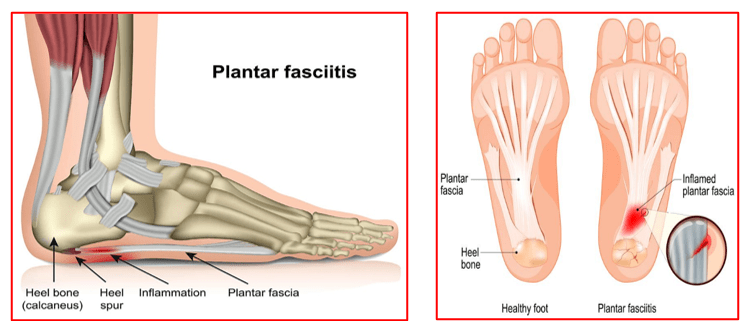Plantar Fasciitis
The plantar fascia is a flat band of tissue that runs along the length of the sole of the foot and along with various ligaments and muscles of the foot, functions to assist in maintaining its inner arch (like the string of a bow, with the bones of the foot being the bow itself).
Plantar fasciitis is an inflammation of the origin of the fascia at the calcaneus (heel bone). It is a result of repetitive strain and the consequent tear and repair processes going on in the worn-out fascia from traction forces. It is like an elastic band that has been left out in the sun and stretched too many times; it loses its stretch and has many microtears in it.
Heel spurs are bony projections that occur at the origin of the flexor digitorum brevis muscle, which lies just beneath the plantar fascia. These spurs probably form because of the local inflammation, tissue calcification and bone formation within the soft tissue, as an attempt to repair the plantar fascia.
Heel spurs have long been associated with heel pain. They were originally thought to be cause of plantar fasciitis. However, heel spurs are NOT the cause of heel pain associated with plantar fasciitis. They do not need removal for treating heel pain.
Plantar fasciitis is diagnosed based on patient’s typical history & clinical examination
The most common symptom is pain and stiffness at the bottom of the heel. The heel pain may be dull or sharp. The bottom of the foot may also ache or burn. The pain may develop slowly over time or come on suddenly after intense activity.
The pain has some typical features and is often worse:
- In the morning when patient wakes up and starts taking first steps
- After standing or sitting for a longtime
- When climbing stairs
- After high intensity activities
- During walking, running, and jumping sports
Patients may have a painful limp whilst walking. Patients may either have a flat or a high arched foot. They have tenderness at the bottom of the heel and also along the sole of the foot. Patients may have swelling and redness in the heel area. Stretching their toes upwards is painful. They may also have a tight achilles tendon.
X-rays may be normal or show a heel spur or Haglund’s deformity.
Treatment for plantar fasciitis can be conservative or surgical.
Over 90 % patients get pain relief benefits with conservative treatment, but this treatment can last from several months to 2 years before symptoms get better. Most people feel better within 6 to 18 months.
Conservative treatment includes:
- Anti-inflammatory medications to reduce pain and inflammation.
- Heel and foot stretching exercises.
- Ultrasound or shockwave therapy
- Night splints to wear while sleeping to stretch the foot.
- Resting as much as possible for at least a week.
- Wearing soft chappals at home.
- Shoes with heel cushions for outdoor activities or sports.
- Warm or cold fomentation to the painful area 2 to 3 times a day
- This is followed by application of painkiller gel and deep massaging of the heel area.
- Corticosteroid or PRP injections in the heel area, to reduce inflammation & promote healing.

Surgical treatment is indicated, rarely, for a patient who is not responding to above conservative measures even after treatment for 6 to 9 months or for those patients whose symptoms deteriorate severely and affect their daily lifestyle.
Arthroscopic release of plantar fascia is performed under short general anaesthesia or a spinal anaesthesia through 2 tiny portals on each side of the foot. This minimally invasive surgery provides - faster pain relief, less swelling, less pain, ability to immediately weight bear and better cosmesis with tiny scars. Office duties can be started at 1 week. Wound is checked and any sutures removed at 2 weeks. Return to sports can be possible by 6 to 12 weeks with adequate rehabilitation and strength training.
The possible risks and complications associated with plantar fascia release: swelling, stiffness, infection, damage to nerves and blood vessels, blood clot, numbness or discomfort along the outer border of the foot and failure to relieve patient’s symptoms.
Book An Appointment
Private Clinics : Locations & Directions
London Joints Clinic (Pune)
Address
Office S 5, 2nd Floor, North Block, Sacred World Mall,
Opp Sacred Heart Township, Near Jagtap Chowk,
Wanawadi, Pune 411040
Monday, Wednesday & Friday 7 PM to 9 PM
Sunday 11 AM to 1 PM
Appointments
London Joints Clinic ( PCMC )
Address
C/O Dr Nitin’s Physio Clinic,
Opp. Brahma Hotel,
Near Akurdi Post Office,
Vivek Nagar,
Akurdi,
Pune 411035
Saturdays only 4.30 PM to 7.30 PM
Appointments
Hospitals OPDs : Locations & Directions
Manipal Hospital

Address
Manipal Hospital, Opp D Mart, Baner-Mhalunge Road, Baner, Pune 411 045
Monday to Saturday 11 AM to 4 PM
Appointments
Contact us
Dr Anand Jadhav has a centralised appointment system for all locations across various hospitals and clinics in Pune & PCMC areas
Appointment Bookings & Requests can be made by any method :

